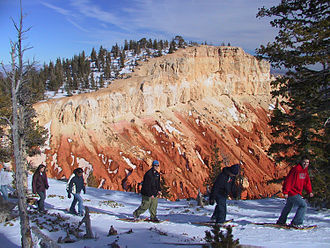AY Honors/Snowshoeing/Answer Key
Snowshoes are a form of footwear devised for travelling over snow. They work by distributing the weight of the person over a larger area so that the person's foot doesn't sink into the snow. Traditional showshoes have a hardwood frame with leather lacings. Some modern snowshoes are similar, but made of light metal while others are a single piece of plastic attached to the foot to spread the weight. In addition to distributing the weight, snowshoes are generally raised at the toe for maneuverability. They must not accumulate snow, hence the latticework, and require bindings to attach them to the feet.
Nearly every Native American tribe developed its own particular shape of shoe, the simplest and most primitive being those of the far north. The Inuit have two styles, one being triangular in shape and about 18 inches (45 cm) in length, and the other almost circular. Southward the shoe becomes gradually narrower and longer, the largest being the hunting snow-shoe of the Cree, which is nearly 6 ft. long (more than 1.5 meters) and turned up at the toe. The stereotypical snowshoe resembles a tennis racquet.
Snowshoes were slowly adopted by Europeans in America, with the French voyageurs well in advance of British settlers. Snowshoes worn by lumberjacks are about 40 inches (1 m) long and broad in proportion, while the tracker's shoe is over 5 feet long (1.5 m) and very narrow. This form was copied by the Canadian snowshoe clubs, but shortened to about 40 inches long (1 m) and 15 to 18 inches broad (about 40 to 45 cm), slightly turned up at the toe and terminating in a kind of tail behind. This is made very light for racing purposes, but much stouter for touring or hunting. The tail has the effect of keeping the shoe straight while walking.
Traditional snowshoes are made of a single strip of some tough wood, usually hickory, curved round and fastened together at the ends and supported in the middle by a light cross-bar, the space within the frame thus made being filled with a close webbing of dressed caribou or neat's-hide strips, leaving a small opening just behind the cross-bar for the toe of the moccasined foot. They are fastened to the moccasin by leather thongs, sometimes by buckles. Such shoes are still made and sold by native peoples.
Modern showshoes take advantage of technical advances in avionics and plastics to make a lighter and more durable shoe using modern materials.
The method of walking is to lift the shoes slightly and slide the overlapping inner edges over each other, thus avoiding the unnatural and fatiguing "straddle-gait" that would otherwise be necessary. The walker, particularly the lead walker, must break a trail in the snow. The method of overlapping assists in making the path. Immoderate snowshoeing leads to serious lameness of the feet and ankles which the Canadian voyageurs call mal de raquette.
Snowshoe racing is very common in the Canadian snowshoe clubs, and one of the events is a hurdle-race over hurdles 3 ft. 6 in. high. Owing to the thick forests of America the snowshoe was found more suitable than the cross-country ski, which is, however, much used in the less-wooded districts or on trails, often those made by snowshoers.

